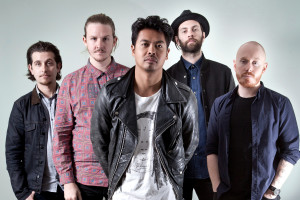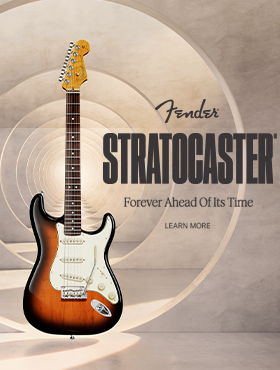THE TEMPER TRAP
July 1, 2009 | Author: Peter Hodgson
 So you’re about to move to the UK. What’s the plan once you get there?
So you’re about to move to the UK. What’s the plan once you get there?
Dougy Mandagi: Well we were gonna settle down, have a snooze, get over our jetlag, but we might be doing that on a bench in Hyde Park now!
Toby Dundas: Yeah, we just found out we don’t have a house any more. We thought we had a place and it just fell through!
Mandagi: We’ll survive.
Dundas: We have a bunch of shows, we’ve got some festivals, so we’re going to start to kinda make a little name for ourselves over there.
The British press seem to be talking you up quite a bit.
Dundas: Yeah, it’s an amazing feeling and you feel a bit privileged because there are so many great bands who never even get that opportunity. So to even have people say nice things about you and get to take those trips and play overseas, you feel pretty lucky.
Things seem to have been moving pretty quickly since the end of last year. What’s it been like to have things really start to take off?
Mandagi: It’s a great feeling. It’s very flattering. It’s surreal at times. Our first trip overseas in September was like, “What? We’ve dreamed about this!” but it was only a dream until pretty much when we landed. So yeah, it’s an amazing feeling, it’s a rush.
You spent some time over there working on the forthcoming album?
Dundas: About three weeks. We did the bulk of it at Sing Sing in Richmond. That’s an amazing studio. But several of their pieces of amazing gear broke while we were there, including the desk we were working on, which caused a few problems.
Mandagi: The ping-pong table prevailed!
Dundas: Yeah, the ping-pong table was at all times in working order! They looked after us so well in the studio. It’s a really nice environment to record it. Some studios are really dreary and there’s no sunlight or anything, which kind of contributes to the cabin fever that it’s very easy to get. But Sing Sing kept us happy and kept us really geed up to give our best to the recording. Jim (Abbiss, producer) was great at pulling amazing drum sounds and amazing guitar sounds for every song.
How much of the band’s sound is from the writing stage, and how much is from the studio?
Dundas: When you talk about ‘the sound,’ that unifying of disparate styles, I think that came somewhat in the studio because that’s something we talked about a lot. We had some songs that fitted together and there were lots of outliers that were in different styles. When we worked with Jim we hoped he’d be able to find something that would tie them together sonically. So I think that came in the studio, but the songs were fairly well written before in terms of structures. Jim brought a lot of sonic tricks to it but we had a lot of time to work on the songs ourselves before we ever got through the door.
So how much of the little orchestrational stuff was there beforehand?
Dundas: A lot of that stuff was there, because we’d do it in Pro Tools. Dougy would come up with the melodies and we’d bang it out in Ableton using a dodgy string patch.
How do you go about reproducing that live?
Dundas: It all happens with the aid of…
Mandagi: The magic sixth member!
Dundas: The Roland SPDS! We trigger a lot of samples during the set, and we got an extra player in as well, just before we recorded, knowing we were going to be using a lot of these atmospherics and beats and bleeps.
What kind of gear did you use on the album?
Dundas: Drum-wise I believe it was a 1964 Ludwig Super Classic, which was an amazing drum kit. A Ludwig Black Beauty snare ended up being on about 75% of the songs. (To Mandagi) What was that amp you guys used?
Mandagi: My amp was a 60s Vox.
Dundas: Yeah, a vintage Vox. That made it on a lot of things. Jonny (Aherne, bass) used an old Fender, clapped-out guitar amp that was pretty much broken, but sounded really good broken. Most of the keyboards are done on our Casio keyboard, and we used a bit of Hammond on one song, but it sits under the Casio.
Mandagi: The Casio reigned supreme!
Dundas: We keep it real! No pedals on it or anything. It’s got two sounds that are really good.
Mandagi: And no other keyboard can work with it.
Apart from the Casio, were there any other tricks in the studio?
Dundas: Oh the Dictaphone! We had this song called ‘Love Lost.’ Often when you’re in the rehearsal room you record little melody ideas on the Dictaphone, and we’d do that a lot. The song had no chorus for ages and we were encouraging Dougy to write a big vocal chorus. He had this one melody idea which was on this Dictaphone and we were in the studio searching, thinking ‘What can we add to this song?’ Jonny pulls out this Dictaphone and plays this tape that’s half chewed. Jim turns around from the desk and is like, “What the hell’s that?” He grabs it, plugs it in, records it into the song and messes around with it a little bit and suddenly we have this chorus. So that was the weirdest studio trick.
The Temper Trap’s debut album ‘Conditions’ is to be released in Australia on July 19, 2009. The ‘Science of Fear’ 7” single is out now.


